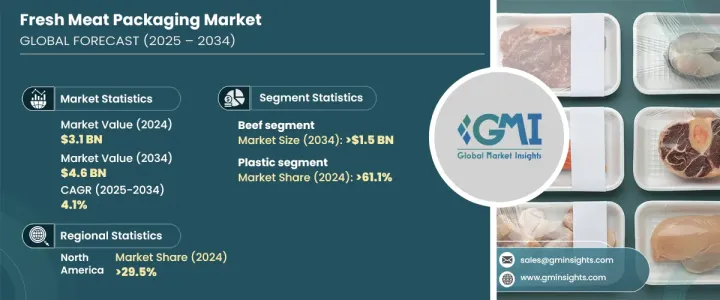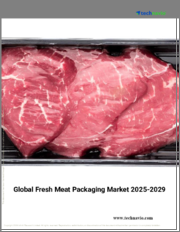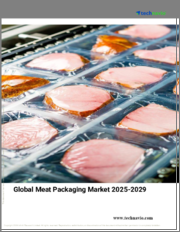
|
시장보고서
상품코드
1685073
신선육 포장 시장 기회, 성장 촉진 요인, 산업 동향 분석, 예측(2025-2034년)Fresh Meat Packaging Market Opportunity, Growth Drivers, Industry Trend Analysis, and Forecast 2025 - 2034 |
||||||
세계의 신선육 포장 시장은 2024년 31억 달러로 평가되었으며, 선진적이고 지속 가능한 포장 솔루션에 대한 수요가 증가함에 따라 2025년부터 2034년까지 4.1%의 안정적인 CAGR로 성장할 것으로 예상됩니다.
소비자의 기대가 환경 친화적인 방향으로 이동하는 동안 제조업체는 제품의 품질과 신선도를 확보하면서 이러한 수요에 부응하려고 노력하고 있습니다. 육류포장업계는 식품안전성 강화, 보존기간 연장, 세계의 지속가능성에 대한 노력과의 정합에 강력하게 초점을 맞추면서 큰 변혁기를 맞이하고 있습니다. 이러한 변화는 재활용 가능한 필름, 생분해성 플라스틱, 추적 및 모니터링 기능을 갖춘 스마트 패키징 솔루션을 포함한 혁신적인 소재 및 기술의 채택으로 촉진됩니다. 보다 환경친화적인 대체품에 대한 동향은 소비자 수요에 부응할 뿐만 아니라 진화하는 규제 기준을 준수하고 환경에 미치는 영향을 줄이기 위한 전략적 노력이기도 합니다.

신선육 포장 시장은 플라스틱, 종이, 판지, 금속 등으로 분류됩니다. 2024년에는 플라스틱 부문이 61.1%의 점유율을 차지하고 시장을 독점했습니다. 이것은 재활용 가능하고 생분해성 플라스틱 소재의 발전 덕분에 환경에 대한 해를 최소화하면서 식육의 신선도를 오래 유지시키는 데 도움이 됩니다. 진공 밀봉 포장 및 가스 치환 포장(MAP)과 같은 기술이 점점 대중화되고 있습니다. 이러한 기술은 육류 품질을 유지할뿐만 아니라 기업이 제품의 신선도와 지속가능성의 목표를 균형있게 전반적인 환경 발자국을 줄입니다. 재활용 가능한 크림프 필름으로의 전환이 진행되고 있는 것도, 환경에 배려한 소재를 요구하는 포장 업계의 폭넓은 움직임을 나타내고 있습니다.
| 시장 범위 | |
|---|---|
| 시작 연도 | 2024년 |
| 예측 연도 | 2025-2034년 |
| 시작 금액 | 31억 달러 |
| 예측 금액 | 46억 달러 |
| CAGR | 4.1% |
신선육 포장 시장은 닭고기, 수산물, 쇠고기, 돼지고기 등으로 구분됩니다. 이 중 쇠고기 분야는 CAGR 4.5%로 가장 높은 성장을 이루었으며, 2034년에는 15억 달러에 달할 것으로 예측되고 있습니다. 제품의 신선도와 소비자의 편의성을 모두 높이는 패키징 솔루션에 대한 수요가 증가하는 것이 이 부문의 성장을 가속하는 주요 요인입니다. 진공 밀봉 포장이나 MAP 기술 등의 혁신이 견인역이 되어 지속가능하고 기능적인 포장에 대한 수요 증가에 대응하고 있습니다. 소비자의 지속가능성에 대한 관심 증가는 육류포장에서 재활용가능한 소재와 퇴비화가능한 소재에 대한 선호도를 높여 업계 동향을 더욱 형성하고 있습니다. 제품 조달의 투명성과 친환경 패키징 솔루션은 육류 포장 산업에 계속 영향을 줄 것으로 예상됩니다.
북미에서는 신선육 포장 시장이 2024년 시점에서 29.5%의 점유율을 차지했으며, 미국이 지속 가능한 포장 솔루션의 채용으로 선도하고 있습니다. 재활용 가능한 플라스틱, 생분해성 필름, 식물 유래 대체 포장에 대한 수요가 증가하고 있습니다. 또한, 추적성을 위한 신선도 표시기 및 QR 코드 등의 스마트 포장 기능의 이용이 보급되어 육류 제품의 안전성, 편리성, 투명성이 향상되고 있습니다. 이러한 혁신은 소비자 수요를 충족시킬 뿐만 아니라 포장재의 이산화탄소 배출량을 줄이는 업계의 노력도 지원하고 있습니다.
목차
제1장 조사 방법과 조사 범위
- 시장 범위와 정의
- 기본 추정과 계산
- 예측 계산
- 데이터 소스
제2장 주요 요약
제3장 업계 인사이트
- 생태계 분석
- 밸류체인에 영향을 주는 요인
- 혁신
- 장래의 전망
- 제조업체
- 유통업체
- 이익률 분석
- 주요 뉴스와 대처
- 규제 상황
- 영향요인
- 성장 촉진요인
- 지속 가능한 패키징을 위한 재활용 가능한 클린 필름에 대한 수요 증가
- 신선하고 위생적인 육류제품에 대한 소비자의 기호의 고조
- 가처분 소득 증가와 식생활의 기호의 변화
- 보다 뛰어난 배리어성을 제공하는 소재의 혁신
- 진공포장 및 가스 치환 포장(MAP) 수요 증가
- 업계의 잠재적 위험 및 과제
- 선진적이고 지속 가능한 패키징 재료의 높은 비용
- 대체 단백질 제품과의 경쟁에 의한 생육 수요 감소
- 성장 촉진요인
- 성장 가능성 분석
- Porter's Five Forces 분석
- PESTEL 분석
제4장 경쟁 구도
- 소개
- 기업 점유율 분석
- 경쟁 포지셔닝 매트릭스
- 전략 전망 매트릭스
제5장 시장 추정 및 예측 : 재료 유형별, 2021년-2034년
- 주요 동향
- 플라스틱
- 폴리에틸렌(PE)
- 폴리염화비닐(PVC)
- 폴리스티렌(PS)
- 기타
- 종이 및 판지
- 금속
- 기타
제6장 시장 추정 및 예측 : 고기 유형별, 2021년-2034년
- 주요 동향
- 쇠고기
- 돼지고기
- 닭고기
- 수산물
- 기타
제7장 시장 추정 및 예측 : 포장 형태별, 2021년-2034년
- 주요 동향
- 트레이
- 가방 & 파우치
- 랩 & 필름
- 뚜껑 필름
- 기타
제8장 시장 추정 및 예측 : 포장 기술별, 2021년-2034년
- 주요 동향
- 가스 치환 포장
- 진공 스킨 포장
- 진공 열성형 포장
- 케이스 레이디 포장
- 액티브 포장
- 기타
제9장 시장 추정 및 예측 : 지역별, 2021년-2034년
- 주요 동향
- 북미
- 미국
- 캐나다
- 유럽
- 영국
- 독일
- 프랑스
- 이탈리아
- 스페인
- 러시아
- 아시아태평양
- 중국
- 인도
- 일본
- 한국
- 호주
- 라틴아메리카
- 브라질
- 멕시코
- 중동 및 아프리카
- 남아프리카
- 사우디아라비아
- 아랍에미리트(UAE)
제10장 기업 프로파일
- Amcor
- Berry Global
- Bollore
- Coveris
- DS Smith
- Easypak
- Faerch
- Multivac
- Pactiv Evergreen
- Point Five Packaging
- Sealed Air
- Sealpac International
- Smurfit Kappa
- Ulma Packaging
- Uniflex Packaging
- Winpak
- Wonder Packagings
The Global Fresh Meat Packaging Market is valued at USD 3.1 billion in 2024 and is expected to expand at a steady CAGR of 4.1% from 2025 to 2034, driven by the increasing demand for advanced and sustainable packaging solutions. As consumer expectations shift towards eco-friendly practices, manufacturers are striving to meet these demands while ensuring product quality and freshness. The meat packaging industry is undergoing significant transformation, with a strong focus on enhancing food safety, prolonging shelf life, and aligning with global sustainability efforts. This shift is being fueled by the adoption of innovative materials and technologies, including recyclable films, biodegradable plastics, and smart packaging solutions with tracking and monitoring capabilities. The trend toward greener alternatives is not only a response to consumer demand but also a strategic effort to adhere to evolving regulatory standards and reduce environmental impact.

The market for fresh meat packaging is categorized into plastic, paper & paperboard, metal, and others. In 2024, the plastic segment dominated the market, capturing a 61.1% share. This is largely due to advancements in recyclable and biodegradable plastic materials that help extend the freshness of meat while minimizing environmental harm. Technologies such as vacuum-sealed packaging and modified atmosphere packaging (MAP) are becoming increasingly popular. These technologies not only preserve meat quality but also reduce the overall environmental footprint as companies work to balance product freshness with sustainability goals. The growing shift toward recyclable cling films also indicates a broader movement in the packaging industry toward environmentally conscious materials.
| Market Scope | |
|---|---|
| Start Year | 2024 |
| Forecast Year | 2025-2034 |
| Start Value | $3.1 Billion |
| Forecast Value | $4.6 Billion |
| CAGR | 4.1% |
The fresh meat packaging market is further segmented into poultry, seafood, beef, pork, and others. Among these, the beef segment is projected to experience the highest growth, with an anticipated CAGR of 4.5%, reaching USD 1.5 billion by 2034. The rise in demand for packaging solutions that enhance both product freshness and consumer convenience is a major factor driving growth in this segment. Innovations such as vacuum-sealed packaging and MAP technologies are gaining traction, catering to the increasing demand for sustainable and functional packaging. Consumers' heightened focus on sustainability is leading to a growing preference for recyclable and compostable materials in meat packaging, further shaping industry trends. Transparency in product sourcing and eco-friendly packaging solutions is expected to continue to influence the meat packaging industry.
In North America, the fresh meat packaging market holds a 29.5% share as of 2024, with the United States leading the way in adopting sustainable packaging solutions. The demand for recyclable plastics, biodegradable films, and plant-based packaging alternatives is on the rise. In addition, the use of smart packaging features such as freshness indicators and QR codes for traceability is becoming more popular, enhancing the safety, convenience, and transparency of meat products. These innovations are not only meeting consumer demand but also supporting industry efforts to reduce the carbon footprint of packaging materials.
Table of Contents
Chapter 1 Methodology & Scope
- 1.1 Market scope & definitions
- 1.2 Base estimates & calculations
- 1.3 Forecast calculations
- 1.4 Data sources
- 1.4.1 Primary
- 1.4.2 Secondary
- 1.4.2.1 Paid sources
- 1.4.2.2 Public sources
Chapter 2 Executive Summary
- 2.1 Industry synopsis, 2021-2034
Chapter 3 Industry Insights
- 3.1 Industry ecosystem analysis
- 3.1.1 Factor affecting the value chain
- 3.1.2 Disruptions
- 3.1.3 Future outlook
- 3.1.4 Manufacturers
- 3.1.5 Distributors
- 3.2 Profit margin analysis
- 3.3 Key news & initiatives
- 3.4 Regulatory landscape
- 3.5 Impact forces
- 3.5.1 Growth drivers
- 3.5.1.1 Increasing demand for recyclable cling films for sustainable packaging
- 3.5.1.2 Growing consumer preference for fresh and hygienic meat products
- 3.5.1.3 Rising disposable income and changing dietary preferences
- 3.5.1.4 Innovations in materials offering better barrier properties
- 3.5.1.5 Rising demand for vacuum and modified atmosphere packaging (MAP)
- 3.5.2 Industry pitfalls & challenges
- 3.5.2.1 High cost of advanced and sustainable packaging materials
- 3.5.2.2 Competition from alternative protein products reducing demand for fresh meat
- 3.5.1 Growth drivers
- 3.6 Growth potential analysis
- 3.7 Porter’s analysis
- 3.8 PESTEL analysis
Chapter 4 Competitive Landscape, 2024
- 4.1 Introduction
- 4.2 Company market share analysis
- 4.3 Competitive positioning matrix
- 4.4 Strategic outlook matrix
Chapter 5 Market Estimates & Forecast, By Material Type, 2021-2034 (USD Billion & Kilo Tons)
- 5.1 Key trends
- 5.2 Plastic
- 5.2.1 Polyethylene (PE)
- 5.2.2 Polyvinyl chloride (PVC)
- 5.2.3 Polystyrene (PS)
- 5.2.4 Others
- 5.3 Paper & paperboard
- 5.4 Metal
- 5.5 Others
Chapter 6 Market Estimates & Forecast, By Meat Type, 2021-2034 (USD Billion & Kilo Tons)
- 6.1 Key trends
- 6.2 Beef
- 6.3 Pork
- 6.4 Poultry
- 6.5 Seafood
- 6.6 Others
Chapter 7 Market Estimates & Forecast, By Packaging Format, 2021-2034 (USD Billion & Kilo Tons)
- 7.1 Key trends
- 7.2 Trays
- 7.3 Bags & pouches
- 7.4 Wraps & films
- 7.5 Lidding films
- 7.6 Others
Chapter 8 Market Estimates & Forecast, By Packaging Technology, 2021-2034 (USD Billion & Kilo Tons)
- 8.1 Key trends
- 8.2 Modified atmosphere packaging
- 8.3 Vacuum skin packaging
- 8.4 Vacuum thermoformed packaging
- 8.5 Case-ready packaging
- 8.6 Active packaging
- 8.7 Others
Chapter 9 Market Estimates & Forecast, By Region, 2021-2034 (USD Billion & Kilo Tons)
- 9.1 Key trends
- 9.2 North America
- 9.2.1 U.S.
- 9.2.2 Canada
- 9.3 Europe
- 9.3.1 UK
- 9.3.2 Germany
- 9.3.3 France
- 9.3.4 Italy
- 9.3.5 Spain
- 9.3.6 Russia
- 9.4 Asia Pacific
- 9.4.1 China
- 9.4.2 India
- 9.4.3 Japan
- 9.4.4 South Korea
- 9.4.5 Australia
- 9.5 Latin America
- 9.5.1 Brazil
- 9.5.2 Mexico
- 9.6 MEA
- 9.6.1 South Africa
- 9.6.2 Saudi Arabia
- 9.6.3 UAE
Chapter 10 Company Profiles
- 10.1 Amcor
- 10.2 Berry Global
- 10.3 Bollore
- 10.4 Coveris
- 10.5 DS Smith
- 10.6 Easypak
- 10.7 Faerch
- 10.8 Multivac
- 10.9 Pactiv Evergreen
- 10.10 Point Five Packaging
- 10.11 Sealed Air
- 10.12 Sealpac International
- 10.13 Smurfit Kappa
- 10.14 Ulma Packaging
- 10.15 Uniflex Packaging
- 10.16 Winpak
- 10.17 Wonder Packagings



















